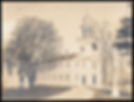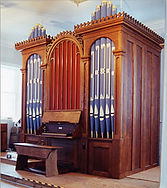
HISTORY
Established in 1769, with the current Meeting House built in 1805, we have a long history in this place.

In order to fulfill the conditions of their charter, the settlers of the district of Lenox, newly separated from Richmond, decided at their first town meeting (1767) to select a site for a meeting house, to provide the support of a minister, and to levy and collect a church tax. The Congregational Church and Society accordingly was organized in 1769 and consisted of nine male members.

IThe first settled minister arrived in 1770, the same year as the first little meeting house was started a few yards southwest of the present building. The rapid growth of the town at the turn of the century rendered the first structure inadequate, and at a special town meeting in 1803, a committee was appointed to build a new meeting house.

In 1961, the congregation voted to join the United Church of Christ to extend the congregation's witness while also honoring its autonomy. By this covenantal tie, we're empowered to respond to the needs of a specific community context. With support from the countywide association, regional conference, and national denomination, the local church is poised to serve for the sake of Christ's universal love in response to what circumstances in any given locale. Church on the Hill is as ever pleased and honored to do in Lenox.
THE MEETINGHOUSE
On January 1, 1806, the new Meeting House was dedicated. Built in two years by Benjamin Goodrich of Richmond, the edifice is a unique blend of the work of two colonial architects who greatly influenced the style of church building structures at that time. The steeple above the clock is an Asher Benjamin design, while the lower tower is after Charles Bulfinch. The rear gallery later was appropriated by the choir, and in 1868, the present tracker action Johnson organ was installed. The floor plan was changed in 1866 to its present arrangement, and in 1880, the front wall was extended eight feet and the present platform and pulpit erected. In 1955, the building was completely electrified and a year-round heating system installed. the Meeting House was placed on the National Register of Historic Places in 1982.

WHAT'S INSIDE


The Johnson Organ | Built in 1869 by William A. Johnson of Westfield, a stonemaker turned organ maker, it is a basic no-frills organ that plays well and holds up well. The organ is a collection of 465 metal and wooden pipes, varying in length from eight feet to one inch. In 2002, the organ was repaired and restored to sound as it was meant to sound 133 years ago by Andover Organ Co., Lawrence, Massachusetts. Here is a report of their work.
Steeple Clock | The original clock was a gift to the town of Lenox by Fanny Kemble in 1849. Because it “did not have an enviable reputation for telling the truth about the time of day,” it was replaced in 1899 with a clock from Seth Thomas & Co., by Mr. Morris K. Jessup.
Bible | The Bible on the table at the rear of the sanctuary was donated by the Honorable William P. Walker in 1862. It replaced the 1818 Bible given by William Walker.
Baptismal Font | Given in 1882 in memory of Sarah and Thomas Egleston.



Pulpit | In 1896, Mrs. Mary Hill Barrett presented the pulpit in memory of her mother, Mrs. Jane Worthington Hill “for many years a faithful member of this church.”

Dr. Shepard Tablet | Miss Eliza Williams donated this tablet in memory of the Rev. Dr. Samuel Shepard, the second pastor of the Church on the Hill, who assumed charge in 1795 at the age of 22 when there were only 15 adult members. In 1806 when this building was dedicated, there were over 100 members. Dr. Shepard’s sermons were often extemporaneous and always vigorous. He died in 1846 and is buried in the cemetery next to the Meeting House. He is the only minister of Church on the Hill “to rest with his people” in that cemetery.
Robbins Fence | The iron and stone fence surrounding the church property was the gift of Mr. Ammi Robbins, a resident of Lenox in 1864. In 1866 his heirs established a fund, the income of which was to be used for maintenance of the fence.
THE CHAPEL
The congregational chapel is located at 55 Main Street. Construction was authorized by the Congregational Society at a meeting on September 2, 1876, in response to a need for a center for social activities. It was completed early the following year on a site formerly occupied by the Lenox Library. The new Chapel, designed by Pittsfield architect Mr. J.F. Rathbone, utilized brick and stone from the old library. Built by Mr. J.W. Cooney, the total cost of construction and materials was $1950. Private subscriptions paid for furnishings, frescoed walls and a gothic window which faced the street.


The Chapel was thoroughly remodeled in 1900, then again in 1968 to create classrooms, a library, and offices, and yet again in 1989, when the stained glass window was uncovered and the main floor refurbished. Today, the chapel is enjoyed for meditation, music recitals, prayer services, and intimate weddings.

